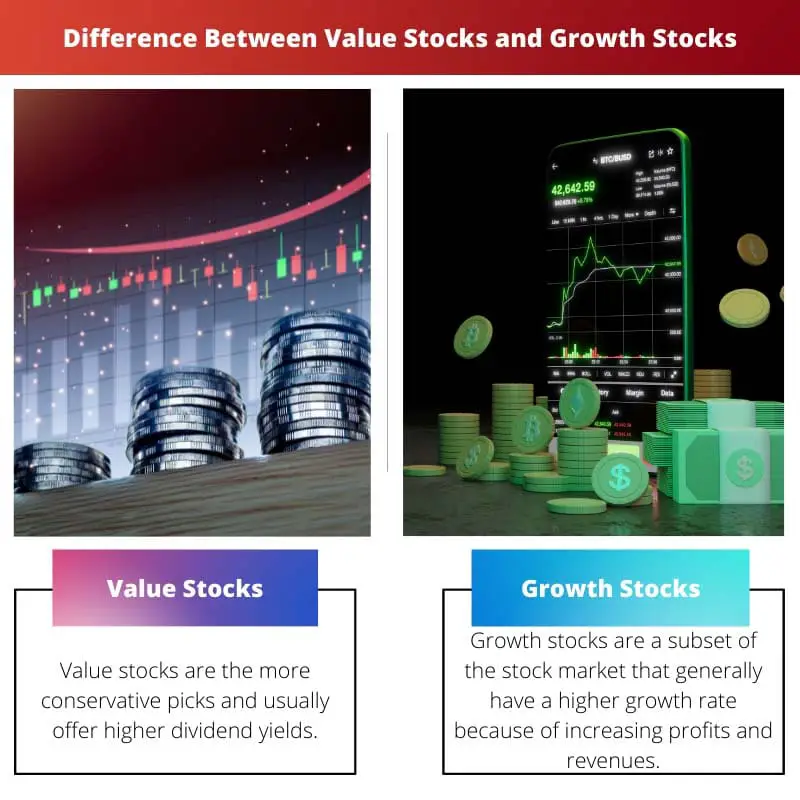Value stocks and Growth Stocks are stocks in companies that are undervalued and valued in comparison to their industry.
However, when it comes to the difference between Value Stocks and Growth Stocks, most investors tend to focus on how Value Stocks and Growth Stocks will affect their portfolios.
Key Takeaways
- Value stocks are undervalued and have lower price-to-earnings ratios, while growth stocks have higher valuations and greater potential for future growth.
- Investors purchase value stocks for their potential capital appreciation and dividend income, while growth stock investors seek capital gains from stock price increases.
- Value investing identifies undervalued companies, whereas growth investing targets companies with strong growth prospects.
Value Stocks vs Growth Stocks
Value stocks tend to be more stable and pay dividends, while growth stocks tend to be riskier and reinvest earnings for future growth. Investors may choose to invest in one or both types of stocks, depending on their investment goals, risk tolerance, and overall portfolio diversification strategy.

Value stocks are stocks in companies that are undervalued in comparison to their industry. Value stock investing is seen as a passive investment. Value companies tend to offer lower-priced shares but also offer strong growth and dividend potential.
Growth stocks are a subset of the stock market. Moreover, they are referred to as “overweight stocks,” and they have a higher growth rate than other types of stocks.
Growth stocks can be risky and profitable; however, they are riskier and provide bigger gains if they perform well.
Comparison Table
| Parameters of Comparison | Value Stocks | Growth Stocks |
|---|---|---|
| Definition | Value stocks are the more conservative picks and offer higher dividend yields. | Growth stocks are a subset of the stock market that have a higher growth rate because of increasing profits and revenues. |
| Risk | Value stocks are not at high risk as they offer higher dividend yields. | Growth stocks, tend to be riskier and provide bigger gains if they perform well. |
| Profit | Value Stocks are the more conservative and profitable but not immensely profitable. | Growth stocks can be both risky and profitable, depending on the investor’s expectations for returns in the future. |
| Volatility | It comes with a lower degree of volatility. | It comes with a higher degree of volatility. |
| Pricing | It is low-priced. | It is high-priced. |
What are Value Stocks?
Value stocks have grown rapidly due to the volatility of riskier investments being on the rise in late. Value stocks are stocks in companies that are undervalued in comparison to their industry.
Typically Value Stocks are sold at a discount when compared to the market. Moreover, Value Stock investing is seen as a passive investment.
A Value Stock is an equity security that has traditionally been considered undervalued by its peers, and investment professionals can use this designation when selecting Value Stocks for their portfolios.
Value companies tend to offer lower-priced shares but also offer strong growth and dividend potential.
They are not the same thing as the companies that are “cheap” or “undervalued” in the financial markets but rather represent similar concepts in terms of price-based value.
Low price-to-book ratios, low P/E ratios, or high dividend yields may characterize value stocks. However, all three metrics can contribute towards the value label.
Value stocks can be found in nearly any industry sector, although the most common range of sectors represented by Value Stocks includes consumer non-cyclical lumber, food, chemicals, industrial metals, telecom, and utilities.

What are Growth Stocks?
Growth stocks can be both risky and profitable, depending on the investor’s expectations for returns in the future, which is why investors must check multiple sources before choosing one Growth Stock investment.
In some cases, Growth Stocks can have more volatility than all other types of individual securities because their fluctuating values correspond with more highly anticipated changes in production rates and more volatile industry trends.
Growth stocks are sometimes referred to as “intrepid stocks” because they tend to perform well when there is investor uncertainty in the market.
This means that Growth Stocks are good for investors who are willing to take on more risk to see better returns.
Growth Stocks are a subset of the stock market. They are referred to as “overweight stocks,” and they have a higher growth rate than other types of stocks.
Investors use these types of stocks to increase their capital gains on their investments for an extended period.
Growth stocks are associated with companies that are in the early stage of their life cycle. These companies could be expanding internationally, introducing new products, or undergoing acquisition by other firms.

Main Differences Between Value Stocks and Growth Stocks
- Value stocks are the more conservative picks and offer higher dividend yields, whereas, Growth stocks are a subset of the stock market that have a higher growth rate because of increasing profits and revenues.
- Value stocks are not at high risk as they offer higher dividend yields, whereas, Growth stocks tend to be riskier and provide bigger gains if they perform well.
- Value Stocks are more conservative and profitable but not immensely profitable, whereas, Growth stocks can be both risky and profitable, depending on the investor’s expectations for returns in the future.
- Value Stocks come with a lower degree of volatility, whereas, Growth stocks come with a higher degree of volatility.
- Value Stocks are low-priced, whereas, Growth stocks are high-priced.

- https://link.springer.com/article/10.1057/palgrave.jam.2240070
- https://www.tandfonline.com/doi/abs/10.2469/faj.v54.n2.2168
- https://www.tandfonline.com/doi/pdf/10.2469/faj.v49.n1.27

Technological, green energy, and consumer discretionary are the most popular sectors for growth stocks.